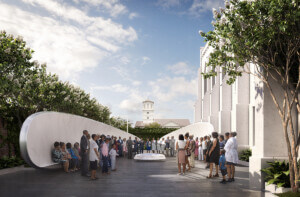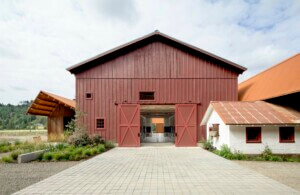Not much was left after a devastating fire ravaged the Westport Presbyterian Church, in Kansas City, Missouri, in 2011. Originally built in 1905, the church saw its roof structure, interior structure, and all interior finishes destroyed. All that remained undamaged was the exterior limestone wall. This is where Kansas City–based BNIM began on what was to become a complete transformation of the neighborhood icon.
Westport Presbyterian Church is located in one of Kansas City’s oldest historic neighborhoods, surrounded by streets lined with vibrantly painted bungalows and cottages. The lively neighborhood was originally the westernmost trading outpost in the region, serving pioneers venturing on the California, Santa Fe, and Oregon Trails, which all converged in Kansas City. By the time the church was built, the area had recently been annexed into the city, which was itself booming thanks to the railroad. The congregation dates to 1835, and the building has been in the same location since just after the Civil War. Yet even before the fire, the church was working to change its relationship with the surrounding community.
“They had already started a process of rethinking what their church would be in the changing culture of Westport,” Erik Heitman, project architect at BNIM, said. “They wanted to re-envision what they were, and how they could serve the community. They not only had to re-envision what their congregation was, but what was the building that serves that mission. They never thought they would rebuild it as it was. This was a chance to reinvent themselves.”
Rather than attempt to return the church to its original design, BNIM worked with the church staff to rethink how the community could use the building. A 1916 addition damaged beyond repair would be replaced by a new structure that included a bright public-facing storefront. A welcoming entrance directly on the street, and its interior space, are now available to local groups. The new construction would also provide space for creating and displaying art by one of the church’s own outreach organizations. Thinking about the outward connection to the community, the exterior space was redesigned to provide places to gather adjacent to corresponding interiors. While adding new functional spaces to the church updated the building’s use and presence in the neighborhood, it would be the restoration of the sacred spaces that would present the greatest challenges.
It took firefighters over 13 hours to extinguish the fire, leaving the building either burned beyond recognition or destroyed by water. The original sanctuary, chapel, second floor, and basement would all have to be completely rebuilt. Yet, elements of the building were salvaged.
Heitman described it as “a new sanctuary delicately placed into the original stone walls.” After a careful restoration, the stained-glass windows were reinstalled in the nave, this time at the parishioner’s eye level. Unable to be used structurally, 40,000 linear feet of the original wood framing was captured for interior finishes as well.
Ironically, one of the new design elements of the sanctuary found its genesis in the temporary space the congregation used after the fire. While only limited natural light was allowed into the original sanctuary through stained glass, the temporary rental space was washed with natural light through clear vision glass. Wanting to include and improve this effect, a ribbon clerestory was added, encircling the entire sanctuary. Effectively filling the space with dramatic natural light, the clerestory also hints at the relationship between the new walls and the now-visible original stonewalls.
While the destruction of a historic building is never a good thing, the long-standing congregation found a way to use it to their advantage. With a vision of what its congregation could be, and help from BNIM, the Westport Presbyterian Church was able to realize a more open and inviting presence in one of Kansas City’s most dynamic neighborhoods.










